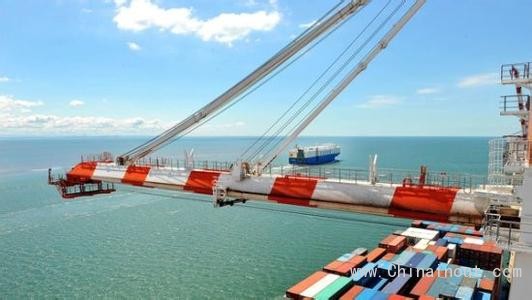
数据显示,今年上半年,全球贸易遭遇自2008年全球金融危机结束以后最大幅度的萎缩。这些数据将让人对全球经济感到担忧,并使有关全球化是否见顶的辩论变得更加热烈。
《世界贸易监测》(World Trade Monitor)报告的发布者——荷兰经济政策研究局(Netherlands Bureau for Economic Policy Analysis)昨日表示,在截至6月的3个月里,全球贸易额下滑0.5%。该局的经济学家还将今年第一季度的全球贸易数据下修至萎缩1.5%。因此,今年上半年的全球贸易状况是自2009年全球贸易因金融危机出现锐减以来最为糟糕的。
根据《世界贸易监测》报告,6月份,全球贸易额实际回升2%,但报告作者警告称,月度数据具有较大波动性,较长期数据更能说明问题。
这些数据是基于最近几年全球贸易的惨淡局面,以及一条数十年的规律的逐渐失效——根据这条规律,由于所谓的“超级全球化”时代,全球贸易持续以全球经济两倍的速度增长。
根据最新数据,在截至6月底的3个月里,全球贸易额与去年同期相比仅增长1.1%。据国际货币基金组织(IMF)预测,全球经济今年将增长3.5%。
世界贸易组织(WTO)首席经济学家罗伯特?库普曼(Robert Koopman)表示:“今年头6个月的情况糟透了。”该组织预测,今年全球贸易额将增长3.3%,但可能会下调这一估计。
库普曼表示,今年全球贸易放缓在很大程度上是由欧洲经济复苏乏力以及中国经济放缓造成的。
全球经济的“增长引擎”好像这一段时间以来发生了机械故障,“一些国家的良好增长被其他国家的疲弱增长抵消”。
除此之外,他表示,全球经济显然也在发生结构性调整,这意味着全球贸易放缓可能会持续一段时间。
库普曼表示,中国正尝试从以出口为导向的经济向更多由内需推动的经济转型,这对全球贸易产生了结构性影响。美国能源领域的变化也是如此,美国正成为能源净出口国。同时,在“近岸”甚至“回流”的趋势中,制造商决定缩短全球供应链,将生产基地设在距离本国更近的地区甚至迁回本土,这也对全球贸易产生了结构性影响。
库普曼表示:“全球经济正在发生调整,在贸易领域,调整正变得非常明显。”
最近几年全球贸易放缓导致一些人声称,全球化已见顶,3D打印等科技创新正在造成进一步破坏。
然而,库普曼表示,尽管全球化可能见顶,但目前没有迹象表明,全球化趋势已逆转。尽管贸易增速已放慢至“与全球GDP增长率相仿”的水平,但作为全球经济中的一个组成部分,贸易仍保持稳定。以2005年不变价格计算,商品出口仍稳稳占据全球产出的三分之一。(中国进出口网)
World trade recorded its largest contraction since the 2008 global financial crisis in the first half of this year, according to figures that will feed concerns over the global economy and add fuel to a debate over whether globalisation has peaked.
The volume of global trade fell 0.5 per cent in the three months to June, the Netherlands Bureau for Economic Policy Analysis, keepers of the World Trade Monitor, said yesterday. Economists there also revised down their result for the first quarter of the year to a 1.5 per cent contraction, making the first half of 2015 the worst recorded since the 2009 collapse in global trade that followed the crisis.
Global trade actually rebounded by 2 per cent in the month of June, according to the World Trade Monitor, but its authors warned that the monthly numbers were volatile and that the more revealing pattern lay in the longer-term figures.
Those numbers built on what has been a grim pattern for global trade in recent years and the unwinding of a decades-old rule that saw trade reliably grow at twice the rate of the global economy as a result of what some have called an era of hyperglobalisation.
In the three months to the end of June global trade grew just 1.1 per cent from the same quarter of 2014, according to the new figures. The International Monetary Fund expects the global economy to grow 3.5 per cent this year.
“We have had a miserable first six months of 2015,” said Robert Koopman, chief economist of the World Trade Organisation, which has forecast 3.3 per cent growth in the volume of global trade this year but is likely to reduce that estimate.
Much of the slowdown in global trade this year has been caused by a faltering recovery in Europe as well as a slowing economy in China, Mr Koopman said.
The global economy’s “growth engine” had been operating as if it had a mechanical fault for some time with “good growth in some countries offset by weak growth in others”.
But there was also clearly a structural shift happening in the global economy, he said, and that meant slowing global trade was likely to endure for some time.
The attempted shift in China from an export-led economy to one that was more driven by domestic consumption had structural implications for global trade, Mr Koopman said. So too did the changing energy dynamics in the US, which is becoming a net exporter of energy, and a pattern of manufacturers deciding to shorten their global supply chains and bring production closer to home as part of a “nearshoring” and even “reshoring” movement.
“There’s an adjustment going on in the global economy and trade is a place wher that adjustment becomes pretty visible,” Mr Koopman said.
The slowdown in global trade in recent years has led some to proclaim that globalisation has peaked with technological innovations like 3D printing already creating further disruptions.
However, while it may have peaked there are no signs yet that globalisation has gone into reverse, Mr Koopman said. While growth in trade has slowed to “mimic global GDP” it remained stable as a component of the global economy, with merchandise exports accounting for a steady third of global output when measured in constant 2005 prices.











